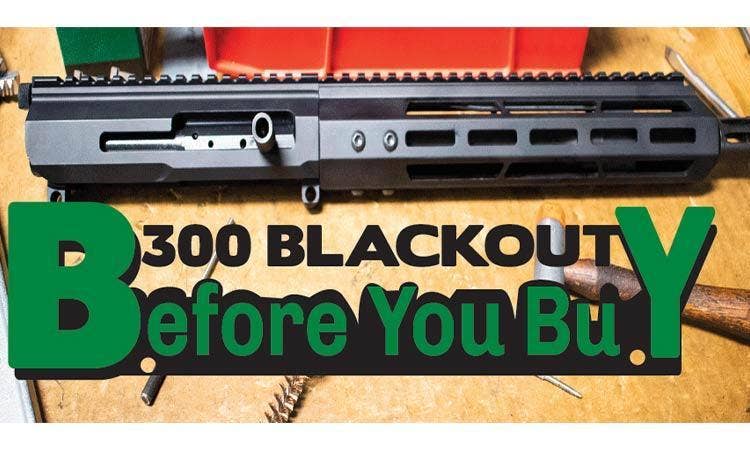Many subscribe to the mistaken belief that secretive operators who work late into the night are the only ones who can experience the advantages and performance of .300 Blackout. There’s no denying the cartridge hits with authority and consistently delivers downrange—even when suppressed through challenging conditions—but lost in the sensationalism is a civilian-friendly versatility that makes a .300 Blackout upper an ideal addition for every AR-15 owner.
The cartridge can be a one-shot stopper on opening day, it’s capable of printing enviable groups and most enthusiasts don’t even need to invest in a new gun to give it a ride. In fact, owners of any .223 Rem.- or 5.56 NATO-chambered AR-15 can simply purchase an upper receiver, install it on their existing lower and in just a few minutes start that first range session. New magazines aren’t even required.
With CNC-tight tolerances today the change is effortless, tool free and adds another facet to the modern sporting rifle. There are uppers in other chamberings available, but few are as versatile and simple to install. Here’s a close look at why you should own a .300 Blackout upper for your .223/5.56-chambered AR-15.
Budget and Option Friendly
Buying a whole new firearm can strain a pocketbook, while adding an upper to your collection is significantly less of a budget strain. Prices vary by model and options, of course, but you’ll be saving cash in the long run, even if you have exotic taste.
It’s tempting to impulsively select an upper that looks great and matches the rails or MLOK handguards on your current AR. There’s money saved and convenience added when you can use some of the same accessories on another upper—particularly those that don’t require the time to resight, like weaponlights, bipods and fore-end grips.
Weigh the upper’s primary purpose foremost. The odds are good that the “off the shelf” complete AR-15 you took home was a manufacturer’s compromise, one designed to appeal to the average enthusiast. This is the chance to finally claim the right barrel, profile, gas system length and even change to a side-charging handle if you prefer. Those choices probably weren’t available when you purchased that .223 Rem. or 5.56 NATO AR. A new upper is the time to build the gun you really wanted in the first place.
Home Defense
A .30-caliber cartridge is a solid choice for home defense. In addition, mounting a larger-caliber upper on that existing lower receiver maintains the fire control feel you’ve come to know well in practice. That familiarity is a welcome advantage during a criminal attack.
Yes, AR safeties and triggers are universally located, but pistol grip width can alter finger position, no two triggers or their resets are quite the same and then there’s the stock. Multiple range sessions have committed operation on your .223Rem./5.56 NATO AR-15 to muscle memory. Adding a .300 Blackout upper on your existing lower puts that practice to work when it really counts, under the stress of a home invasion.
Larger caliber bullets of identical design transfer energy more quickly on target, on average. It’s that fact that makes the .300 Blackout a better choice at self-defense distance, despite the fact energy generated between the two cartridges is relatively close at household distances.
Hornady’s 135-grain FTX .300 Blackout load, for example, leaves the muzzle at 2,085 fps carrying 1,303 ft.-lbs. of energy. The company’s Critical Defense offering in .223 Rem. has a 73-grain FTX bullet. When it leaves the average AR-15 at 2,790 fps it’s generating 1,262 ft.-lbs. of knockdown power.

Numbers vary by manufacturer, bullet and load, but even when the .300 Blackout cartridge is lower in energy calculations, most experts agree it’s a better option for defense. A wider profile, in general, forces its energy to transfer faster when it connects. There’s also a solid argument to be made that slower and fatter projectiles have a harder time passing through walls and traveling to unknown destinations beyond.

Hunting
That increase in horsepower also improves the probability of clean, one-shot stops for hunters. There are many areas in the United States where guns chambered in .223 Rem. or 5.56 NATO are not even legal for pursuit of big game, yet agencies have no problem with AR-15s wearing a .300 Blackout upper. [See what game you can take with 300 Blackout Rifles in our infographic called Hunt with the Perfect Caliber.]
Lack of terminal performance is the reason cited. That .308-diameter bullet makes a huge difference.
Check your local and state regulations, which may have minimum energy requirements, before heading out opening day. And know your load’s ballistics. That big wide projectile bleeds speed and drops faster at long distance than the .22-inch diameter bullets delivered from an AR.
Federal Premium’s Fusion load in .223 Rem., for example, is designed for hunting. It carries a 62-grain bullet and is still traveling 1,671 fps at 500 yards. That translates to 384 ft.-lbs. of energy and if the gun is zeroed at 200 yards the bullet will have dropped 22.8 inches when it gets to that distance.
The company’s 150-grain Fusion offering in .300 Blackout, with the same zero, has dropped a whopping 128.7 inches at 500 yards. It’s still carrying about the same amount of raw energy, 388 ft.-lbs. at 1,079 fps, but most hunters will need to dial that amount of holdover into their scope.
Where the two cartridges diverge significantly downrange varies by load, but there’s no denying the .300 Blackout is extremely reliable out to 200 yards, beyond in practiced hands. If your whitetail hunts are in thick cover or shots rarely stretch to 300, you can’t go wrong with the cartridge.

Sounds of Silence

Adding a .300 Black upper receiver also opens a whole new world of subsonic loads, which keep bullet velocity below the speed of sound. It’s this fact that fuels speculation that the cartridge is really suited for military operations.
Operators behind a suppressor choose these loads to prevent the characteristic “crack” made when the projectile breaks the sound barrier. The “silencer” may hush the gun’s report, but that sonic boom may still print their position. Civilian shooters who have been subjected to that shrill noise during lengthy range sessions, however, come to quickly appreciate that reduction in noise—even when the gun is not wearing a can.
There are subsonic loads available in .223 Rem. and 5.56 NATO, but they’re scarce. Federal Premium and Hornady, for example, don’t have any in their current lineups and there’s good reason. Grade school physics taught us that with every action there’s an equal and opposite reaction. A standard AR cartridge uses that law by generating enough energy to push the bullet forward and out of the gun, while that opposite reaction forces the bolt carrier group back, ejecting brass along the way and compressing the buffer spring sufficiently to start forward motion until the firearm is finally back into battery with a fresh cartridge.
It’s simple science, but when you enforce a speed limit at the sound barrier—since Energy = (Mass) X (Velocity)—the lightweights fail miserably at generating sufficient force to cycle semi-automatic guns.
Ammunition companies address the situation by increasing mass in the equation (heavier bullets). The solution is easy with more wiggle room available in the .300 Blackout, but with the .223 Rem./5.56 NATO the answer get complex. Some firms offer solutions, but they aren’t exactly widespread offerings.
The .300 Blackout cartridge, however, was designed to run with a standard AR-15 lower in a wide range of speeds. It was not invented for bolt-action rifles and subsonic performance was a key consideration during development. It runs flawlessly in nearly all cases, even without breaking the sound barrier, and doing so does not require complex modification or gas system adjustment.
Compact and Versatile
A new upper also doesn’t occupy as much room as a new firearm in a gun safe. There’s another advantage to that compact profile, though. Transporting it and your complete AR to the range or hunting area is easier and lighter than hauling a pair of fully assembled guns. You’ll appreciate that versatility when the big game is on the morning schedule, followed by varmints at noon.
In addition, when .223 Rem. ammo is scarce a .300 Blackout upper doubles your chances of scoring at the sporting goods store. If there’s anything to be learned from 2020, shortages happen.

Simple Install
Installing a .300 Blackout upper is easier and a lot faster than cleaning your AR-15. Simply push out the retaining pins that hold your upper and lower receiver together. Separate the pair and, if you selected a .300 Blackout upper from Bear Creek Arsenal, you don’t even need to remove and swap the bolt carrier group. The company’s models ship with one pre-installed, which makes the task both field-expedient and effortless.
Now, properly align the new upper with the lower receiver. Once the holes are aligned, replace the forwardmost retaining pin and push in until secure. Rotate the receivers together and push in the last pin.
You’re done. Standard AR-15 magazines work with .300 Blackout, so there’s nothing else to purchase. Eliminating any requirement to handle dirty bolt carrier groups also makes cleanup after the process a breeze.
Legal and Readily Available
Most readers know this, but it’s worth dispelling any confusion. AR-15 serial numbers are located on the lower receiver. They are duly recorded during the initial purchase, likely every time after, on an ATF form 4473. The purchaser’s personal information, results of their background check and other details are included on the paperwork, but that lower receiver is, by ATF standards, the firearm—even when it isn’t attached to an upper receiver.
That fact means putting a .300 Blackout upper, or any other, on a modern sporting rifle you currently own is not against federal law. The change does not require a fresh barrage of paperwork.
Bear in mind, however, mounting an upper receiver that wears a barrel shorter than 16 inches to a rifle or carbine lower receiver requires the purchase of a National Firearms Act (NFA) tax stamp. To do so you must first clear additional background checks, secure chief law enforcement officer permission and wait for approval.
If you own a rifle or carbine, simply stick with upper receivers wearing barrels 16 inches and longer and you’re good. AR-15 pistol owners, on the other hand, can go as long as they want—assuming that exotic setup doesn’t include an aftermarket rifle stock, which would fall under NFA regulations.
Thousands of AR-15 owners do it every year. It’s easy, fast and if you’re considering upgrading your AR-15, why not fully harness your modern sporting rifle’s versatility, economically, by adding a .300 Blackout upper to your collection?
[We'd like to extend a huge thank you to Guy Sagi for his hard work on this article. Check out our other helpful content like infographics and "how to" guides. Leave a comment about what this guide helped you with most and share with your friends on social media!]








